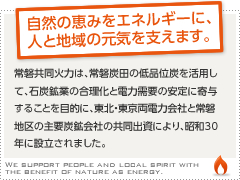Integrated Coal Gasification Combined Cycle (IGCC)
Papers Presented
Progress in NAKOSO 250 MW Air-Blown IGCC Demonstration Project(PDF 2MB)
M.Nunokawa,International Conference on Power Engineering-2013 (ICOPE-2013),2013.10.24
The Completion of the Air-blown IGCC Demonstration Test and its Conversion to Commercial use(PDF 0.5MB)
Y.Ishibashi,World Energy Council,2013.10
Click here for find publications issued by Clean coal power R&D co.ltd. during demonstration test
FY2014(Apr.2014-Mar.2015)
・April,2014 Air blown IGCC won the Japan Society of Mechanical Engineers Award
(Technology) in 2013
The Japan Society of Mechanical Engineers Awards ceremony was held at the Meiji Memorial Hall in Minato-ku, Tokyo. Our presentation, “Development of High Efficiency Air Blown IGCC” won the Japan Society of Mechanical Engineers Awards (Technology) in 2013.
FY2013(Apr.2013.4-Mar.2015)
・December,2013 Nakoso No. 10 unit established the world record for continuous operation time of IGCC (3,917 hours).
Nakoso No. 10 unit continued coal gasification operation from June 28 to December 8, 2013.
The operation time was 3,917 hours. It broke the world record for continuous operation time of IGCC which was set by Bugghenum power station in Netherland.
・November,2013 Nakoso No. 10 unit updated the world record for continuous operation time of IGCC.
Nakoso No. 10 unit started operation as Japan’s first IGCC commercial plant on June 28, 2013, and then continued to operate smoothly after that.
At 13:35 on November 12, 2013,Nakoso No. 10 unit updated the world record for continuous operation time (3,287 hours) of IGCC which was set by Bugghenum power station in Netherland.
・June,2013 Nakoso No.10 unit started commercial operation.
Nakoso No. 10 unit had undergone periodic inspection for three months from March 4, 2013, The commercial operation finally started at 17:00 on June 30, 2013.
・April, 2013 IGCC demonstration plant was converted to commercial plant as Nakoso No. 10 unit.
On April 1, 2013, Joban Joint Power co. ltd. took over the IGCC demonstration plant as Nakoso No. 10 unit for commercial operation from Clean Coal Power R&D Co. , LTD.
| Term | Meaning |
|---|---|
| Amine | A chemical solution used in a gas cleanup process to remove sulfur compounds from coal gas through absorption. |
| Subbituminous coal | While less commonly used as a fuel for coal-fired power generation in Japan, it can provide cost advantages over bituminous coal. With abundant reserves, its use for IGCC is currently being studied. It has lower carbon content and lower calorific values than bituminous coal. |
| Sulfur recovery system | A system used to collect sulfur in the form of gypsum by absorption using limestone slurry following the conversion of sulfur content into sulfur oxides in the off-gas incinerator. |
| Sulfur compound | A compound containing hydrogen sulfide (H2S), carbonyl sulfide (COS), and so forth generated by the gasification of coal. |
| Gasifier | A reacting furnace used to convert pulverized coal into syngas. |
| Gas turbine fuel switching | Switching fuels for the gas turbine between kerosene and coal gas. When starting up the plant, we must use kerosene as fuel for the gas turbine until coal gas is generated in the gasifier. Upon shutdown of operations, kerosene is once again used in place of coal gas. |
| (Char recycling unit) Cyclone separator |
A unit used to collect unburned and fine-particle char from coal gas using centrifugal force. |
| Auxiliary power | Power needed to operate plant equipment such as pumps and fans. |
| Slag | A glassy solid in granular form discharged when the ash in coal is melted inside the high-temperature gasifier and rapidly cooled when dropped into water at the bottom of the gasifier. |
| Coal gasification reaction | A series of reactions in which, after coal breaks down into volatile matter (gases) and char (solid content) when heated, char turns itself into such gases as carbon monoxide (CO) and hydrogen (H2) by reacting with carbon dioxide (CO2), water (H2O) and other substances. |
| Net thermal efficiency | An index used to indicate thermal efficiency obtained by subtracting the power needed to operate a plant from the power generated by the plant. Efficiency here represents how much of the coal energy supplied to a plant becomes electric power. |
| De−NOx unit | A unit used to break down nitrogen oxide into nitrogen (N2) and water (H2O) using ammonium and catalyst to remove nitrogen oxide from flue gas discharged by the gas turbine. |
| Nitrogen compound | A compound that contains nitrogen, e.g., ammonium (NH3), resulting from the combustion of nitrogen content of coal and combustion air. |
| Char | An unburned particles obtained though the removal of volatile content and water from coal in a gasifier composed primarily of ash content and fixed carbon. |
| Dual mode | A mode of operation that permits the use of two types of fuel. While coal gas is normally used as fuel for gas turbines, kerosene (for instance) is used when starting/stopping a plant. |
| Halogen | A family of elements including fluorine (F) and chlorine (Cl). In the case of the demonstration plant under discussion, it refers to any of the elements present in coal gas in the form of hydrogen fluoride (HF), hydrogen chloride (HCl), and so forth. |
| Fly ash | Ash content of coal in powder form. It is generated by combustion inside the boiler used in conventional coal-fired power generation with pulverized coal. |
| (Char recycling unit) Porous filter |
A device used to collect microscopic particles of char from coal gas with a filter. It is located downstream from the cyclone separator. |
| Bituminous coal | A type of coal commonly used as fuel for coal-fired power generation in Japan. It offers the second highest carbon content after anthracite coal and higher calorific values than subbituminous coal. |
| ASU | A unit used to separate nitrogen (N2) and oxygen (O2) in air drawn in from atmosphere. An abbreviation for Air Separation Unit, it is an important part of an IGCC process, which uses nitrogen for the safe transport of pulverized coal and for other functions. |
| LHV | An index used to refer to the energy generated by fuel combustion. An abbreviation for Lower Heating Value, it excludes evaporative latent heat (condensation heat) from the steam generated by combustion and the water content of the fuel. The index including evaporative latent heat (condensation heat) of steam is known as HHV (Higher Heating Value). |
| SGC heat exchanger | A unit used to generate steam for steam turbine operations. Also known as a syngas cooler, it makes use of the heat in coal gas produced in a gasifier. |
Advantage 1 Improved Power Generation Efficiency and Solution to Global Warming
Gasification of coal (solid fuel) allows the combined use of steam and gas turbines, creating the potential to increase estimated power generation efficiency to 48% to 50% (for an IGCC system) in commercial applications, compared to levels of approximately 42% for conventional coal-fired power generation systems.
The foregoing advantage may well lead to coal-based power generation at CO2 emission rates more or less equal to oil based power generation.
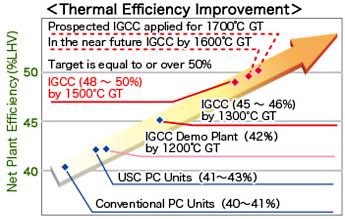
Advantage 2 Wider Choice of Applicable Coal Types
The technology takes advantage of coal, the most abundant of natural resources. The technology can also be used with coal types that have low ash melting temperatures, materials that do not readily lend themselves to use for conventional coal-fired power generation. In this way, the technology may pave the way for a wider choice of usable coal types for Japan.
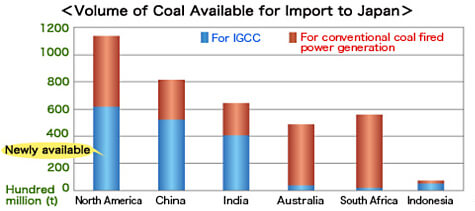
Advantage 3 Atmospheric Environmental performance.
With IGCC, the gasification of coal (solid fuel) enables power generation through a combination of steam and gas turbines, resulting in projected power generation efficiency rates of 48% to 50% in commercial applications, compared to levels of approximately 42% rate for conventional coal fired power generation.
The higher efficiency of the systems will reduce SOx, NOx, and dust emission per unit of electricity generated (kWh).
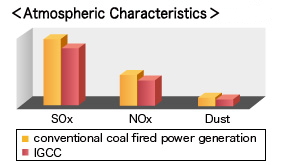
Advantage 4 Effective Use of Slag
Conventional coal-fired power generation produces large volumes of coal ash. IGCC discharges it in the form of glassy slag, cutting volumes of this waste product by nearly half.
This slag can be recycled for other uses, including cement components and road materials.
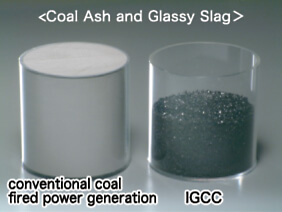
Advantage 5 Other Features
Reduced Cooling Water
Designed as a combined cycle power generation system using a gas turbine, IGCC can reduce cooling water by roughly 30% compared to conventional coal-fired power generation methods.
Reduced Service Water Usage
The flue gas desulfurization equipment used in conventional coal-fired power generation treats emissions(SOx,NOx,Dust) in the exhaust gas phase subsequent to burning of the fuel, an approach that inherently requires large volumes of water. IGCC deals with the emissions during the fuel gas phase, significantly reducing the amount of service water needed.
IGCC(Integrated coal Gasification Combined Cycle)
An IGCC system is designed to achieve higher efficiency than conventional coal-fired power generation systems through the gasification of coal coupled with a combined cycle (CC) process.
| Conventional Coal fired Power Generation | 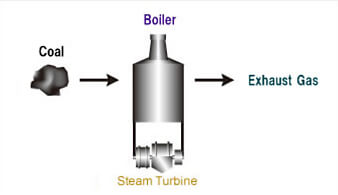 |
| <System configuration> Boiler + Steam turbine |
|
| Coal is burned in the boiler. The expansive force of the resulting steam is used to drive the steam turbine, thereby driving the generator directly connected to it. |
| Combined Cycle (CC) Power Generation | 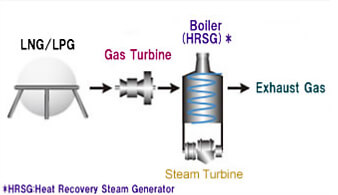 |
| <System configuration> Boiler + Steam turbine + Gas turbine |
|
| Fuel is burned in compressed air to generate combustion gas. The expansive force of the gas is used to drive the gas turbine, thus operating the generator directly connected to it. The high-temperature exhaust gas is supplied to the boiler to generate the steam needed to drive the steam turbine. |
| IGCC | 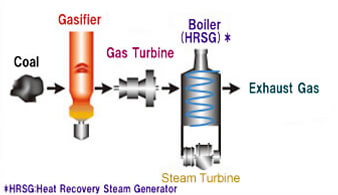 |
| <System configuration> Boiler + Steam turbine + Gas turbine + Gasifier |
|
| Coal is gasified in the gasifier to produce(syn-gas). The syn-gas is led to the gas turbine for burning to drive the gas turbine. The high-temperature exhaust gas is supplied to the boiler to generate the steam needed to drive the steam turbine. |
